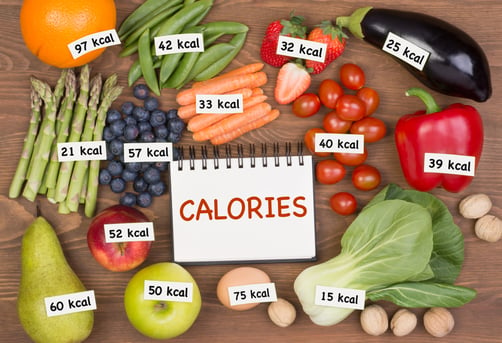How Much of a Calorie Deficit is Too Much?
By: Markita Lewis, MS, RD
Weight loss is a little bit more complicated than “calories in vs. calories out,” but creating a calorie deficit is one of the keys to losing weight. However, more is not always better—creating too much of a calorie deficit may be harmful to your health. Everyone’s body is a bit different, so how can you tell if your calorie deficit is too much?
We will answer that question in this article and also discuss:
- Why you need a certain number of calories daily
- What causes calorie deficits
- Signs that your calorie deficit is too large
- Simple ways on how you can keep track of your calorie deficit
If you want to learn more about finding a healthy calorie deficit for your weight loss, read on.
Why Your Body Needs Calories
Before discussing what a calorie deficit is and the potential consequences of a large calorie deficit, let’s talk about why we need calories in the first place.
A calorie is the potential energy that our bodies can use that is extracted from the foods that we eat.
Our bodies need energy to function, even when we are not being physically active. The energy that we burn at rest is called our resting metabolic rate (RMR). Your RMR supports the basic functions to survive – your breathing, brain functioning, organ functions, muscle movement, and even blood flow throughout your body.1
In all, the RMR accounts for around 60-70% of our body’s total energy use. There are fluctuations in RMR depending on age, sex, hormonal state, body composition, lifestyle, and health status.
When we have insufficient intake of calories or burn too many calories, we run the risk of causing our bodies to not function normally – we’ll get into what can happen later in this article.

How To Be In a Calorie Deficit?
Intentional calorie deficits are caused by individually reducing caloric intake, increasing physical activity, or a combination of the two.
Reducing calorie intake in your diet may look like:
- Choosing water or calorie-free beverages instead of sugar-sweetened beverages or alcohol
- Reducing food portions to recommended sizes
- Limiting intake of high-calorie snacks and desserts
- Increasing intake of fiber-rich foods to reduce hunger
Increasing energy expenditure through physical activity can look like:
- Adding strength training exercises to your routine
- Going for a daily walk, run or skate
- Taking a dance class
- Regularly swimming in a pool
Together, actions like these can create a calorie deficit that can cause weight loss. But things can go overboard.

What Happens When Your Calorie Deficit is Too Much?
As mentioned earlier, our bodies require a minimum number of calories to function properly. When we consistently don’t have enough calories to sustain our bodies, we can experience immediate and long-term side effects.
Immediate symptoms from an excessive calorie deficit may include fatigue, increased irritability, hunger, preoccupation with food, poor sleep, and constipation.2
Long-term calorie deficits can have more damaging consequences to your body, including metabolic derangements. During extreme calorie deficits, hormones can change to slow metabolism, with this effect remaining even after intake has improved.3
Extreme calorie deficits caused by inadequate calorie intake may increase the risk of nutrient deficiencies, which may impact immunity and normal bodily functions.4
A combination of nutrient deficiency and inadequate calorie intake can result in the growth of lanugo hair to provide warmth, reduced blood flow to the fingers and toes, and several skin conditions.5
Severe calorie restriction or too large of a calorie deficit can even cause hormonal changes that lead to reproductive dysfunction in men and women.6

How Can You Calculate Your Optimal Calorie Deficit?
Your target calorie deficit should help you lose weight while maintaining a healthy, functioning body.
According to the Academy of Nutrition and Dietetics, having a calorie deficit of 500 to 1,000 calories per day can result in gradual and healthy weight loss.
A pound of weight on your body is equal to approximately 3,500 calories, so decreasing your normal intake or increasing exercise to make a daily deficit of 500 to 1,000 calories can help you lose up to 1-2 lbs per week.7
To reduce the likelihood of having nutrient deficiencies while having a calorie deficit, there are guidelines for caloric intake:
- Women: 1,200 to 1,500 calories per day
- Men: 1,500 to 1,800 calories per day
Research supports doing moderate to vigorous-intensity physical activity for at least 250 minutes per week (about 35 minutes daily) to see the best results for creating a calorie deficit for weight loss.
These are general guidelines, and if you experience any of the symptoms that may indicate that your calorie deficit is too much, adjust your intake or physical activity accordingly.
Some fitness apps can help calculate your estimated calorie needs and calorie goals for weight loss based on metrics such as age, gender, height, weight, and level of physical activity.
One of the best ways to get individualized advice on what your calorie deficit should be is to consult a registered dietitian. They can assist with monitoring your nutrition and health during your weight loss journey.

Summary
Even if you are looking to create a calorie deficit for weight loss, it is important to meet your body’s basic energy needs to function properly.
Too much of a calorie deficit can slow down your metabolism, cause psychological changes, increase fatigue, and risk your health. A healthy calorie deficit of approximately 500 to 1,000 calories per day can be achieved through managing calorie intake and increasing physical activity.
High-quality fitness apps or consultation with a nutrition professional such as a registered dietitian can help you keep track of your weight loss and how you feel through the process.
References
1. McMurray RG, Soares J, Caspersen CJ, McCurdy T. Examining variations of resting metabolic rate of adults: a public health perspective. Med Sci Sports Exerc. 2014;46(7):1352-1358. doi:10.1249/MSS.0000000000000232
2. Watkins E, Serpell L. The Psychological Effects of Short-Term Fasting in Healthy Women. Front Nutr. 2016;3:27. Published 2016 Aug 22. doi:10.3389/fnut.2016.00027
3. Rosenbaum M, Leibel RL. Adaptive thermogenesis in humans. Int J Obes (Lond). 2010;34 Suppl 1(0 1):S47-S55. doi:10.1038/ijo.2010.184
4. Hagmar M, Hirschberg AL, Berglund L, Berglund B. Special attention to the weight-control strategies employed by Olympic athletes striving for leanness is required. Clin J Sport Med. 2008;18(1):5-9. doi:10.1097/JSM.0b013e31804c77bd
5. Strumia R. Skin signs in anorexia nervosa. Dermatoendocrinol. 2009;1(5):268-270. doi:10.4161/derm.1.5.10193
6. Martin B, Golden E, Carlson OD, Egan JM, Mattson MP, Maudsley S. Caloric restriction: impact upon pituitary function and reproduction. Ageing Res Rev. 2008;7(3):209-224. doi:10.1016/j.arr.2008.01.002
7. Raynor HA, Champagne CM. Position of the Academy of Nutrition and Dietetics: Interventions for the Treatment of Overweight and Obesity in Adults. J Acad Nutr Diet. 2016;116(1):129-147. doi:10.1016/j.jand.2015.10.031





